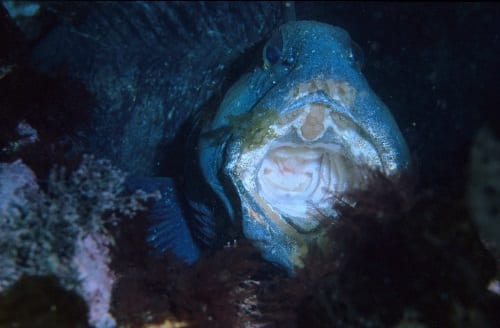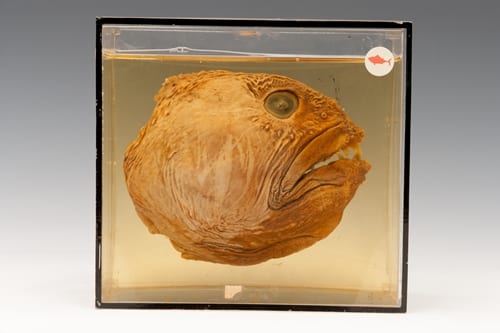Specimen of the Week 320: the wolffish head
By Will J Richard, on 8 December 2017
Hello e-readers! Will Richard here bringing you an almost festive Specimen of the Week. Though, if I’m honest, there is absolutely nothing festive about half a fish head.
**The Wolffish Head**
“…the better to eat you with…”
Wolffish (members of the Anarhichadidae family) are a group of five recognised species of eel-like, predatory fish native to the Atlantic and Pacific Oceans at depths of up to 600 metres. They get their name from their large and obvious “canine” teeth, though despite their fierce appearance they don’t hunt big prey. Instead wolffish use these teeth to crack open the shells of invertebrates on the sea floor to feed on the soft tissue beneath. Their teeth are massive, however, and their jaws powerful, so a provoked wolffish can still rip a chunk out of almost anything it chooses to…
Cold blooded
They often hunt in deep, very cold water with temperatures well below zero degrees Celsius. To stop their blood literally freezing (a genuine danger!) wolffish produce a molecule known as type iii antifreeze protein. This compound circulates in the fish’s blood, blocking the formation of ice crystals by binding to their surface.

Atlantic wolffish, Newfoundland. Image by Derek Keats; via Wikimedia Commons; CC BY 2.0
Caught up
Although there has been little formal assessment of wolffish populations worldwide, the UN’s Food and Agriculture Organization does provide some data. Fishing in the Northeast Atlantic (so therefore primarily of the Atlantic species (Anarhichas lupus)) reached a peak of 33,400 tonnes in 1964. The largest ever recorded Atlantic wolffish weighed just under 18 kilogrammes though this is exceptional and most studies put the average at about 3 kilogrammes. The calculation is simple, but the results extraordinary: in 1964 we caught approximately 11,133,333 wolf fish from the Atlantic alone… over 11 million…
Stuck in a rut
This has declined significantly (there are far fewer to catch!) to a mere 15,044 tonnes (in 2011). Still a staggering figure and even crazier given that the vast majority are caught “accidentally”. That’s not to say wolffish aren’t eaten, but they aren’t commonly eaten and so aren’t commonly targeted. Bottom trawling, which commercial fishing now relies on, cannot discriminate between fish you want and fish you don’t. If it’s in the net you catch it though bycatch, the technical term for “got stuck in the net”, isn’t the only problem. Wolffish need stable, healthy sea beds to survive. Trawler nets are big and heavy. They can weigh tonnes and are dragged for miles along the bottom. This destroys coral, rips up boulders and stirs up any toxic chemicals that were safely buried in the sediment. Wolffish populations have declined by as much as 96% in some areas.
References:
Mariève Desjardins, Nathalie R. Le François, Garth L. Fletcher, Pierre U. Blier, High antifreeze protein levels in wolffish (Anarhichas lupus) make them an ideal candidate for culture in cold, potentially ice laden waters, In Aquaculture, Volume 272, Issues 1–4, 2007, Pages 667-674, ISSN 0044-8486, https://doi.org/10.1016/j.aquaculture.2007.08.016.
Will Richard is Visitor Services Assistant at the Grant Museum of Zoology
 Close
Close



